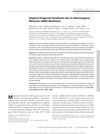TLDR Progeria, a disease that causes early aging, is linked to a gene mutation and helps us understand normal aging.
The chapter reviewed Hutchinson–Gilford progeria syndrome (HGPS), a rare and fatal premature aging disease caused by mutations in the LMNA gene, leading to the production of progerin. HGPS presents symptoms similar to physiological aging, such as alopecia, osteoporosis, and cardiovascular diseases, making it a valuable model for studying aging. The chapter covered the genetic and clinical background of HGPS, current therapeutic approaches, mouse models mimicking HGPS features, proposed molecular mechanisms, and the relationship between HGPS and physiological aging.
 39 citations
,
January 2019 in “Cells”
39 citations
,
January 2019 in “Cells” Gene therapy has potential as a future treatment for Hutchinson-Gilford progeria syndrome.
2 citations
,
June 2018 in “International Journal of Pharmacological Research” Hutchinson-Gilford Progeria Syndrome caused rapid aging due to a genetic mutation, with treatments to manage symptoms.
 June 2023 in “GSC Advanced Research and Reviews”
June 2023 in “GSC Advanced Research and Reviews” Hutchinson-Gilford Progeria Syndrome causes rapid aging from a genetic mutation, with no cure but ongoing research into potential treatments.
March 2011 in “Open Archive (Karolinska Institutet)” The mouse model showed defects in adult stem cell maintenance related to Hutchinson-Gilford progeria syndrome.
 115 citations
,
October 2009 in “The Journal of clinical endocrinology and metabolism/Journal of clinical endocrinology & metabolism”
115 citations
,
October 2009 in “The Journal of clinical endocrinology and metabolism/Journal of clinical endocrinology & metabolism” The research found that Atypical Progeroid Syndrome has unique symptoms and is not caused by the buildup of a certain mutant protein.


